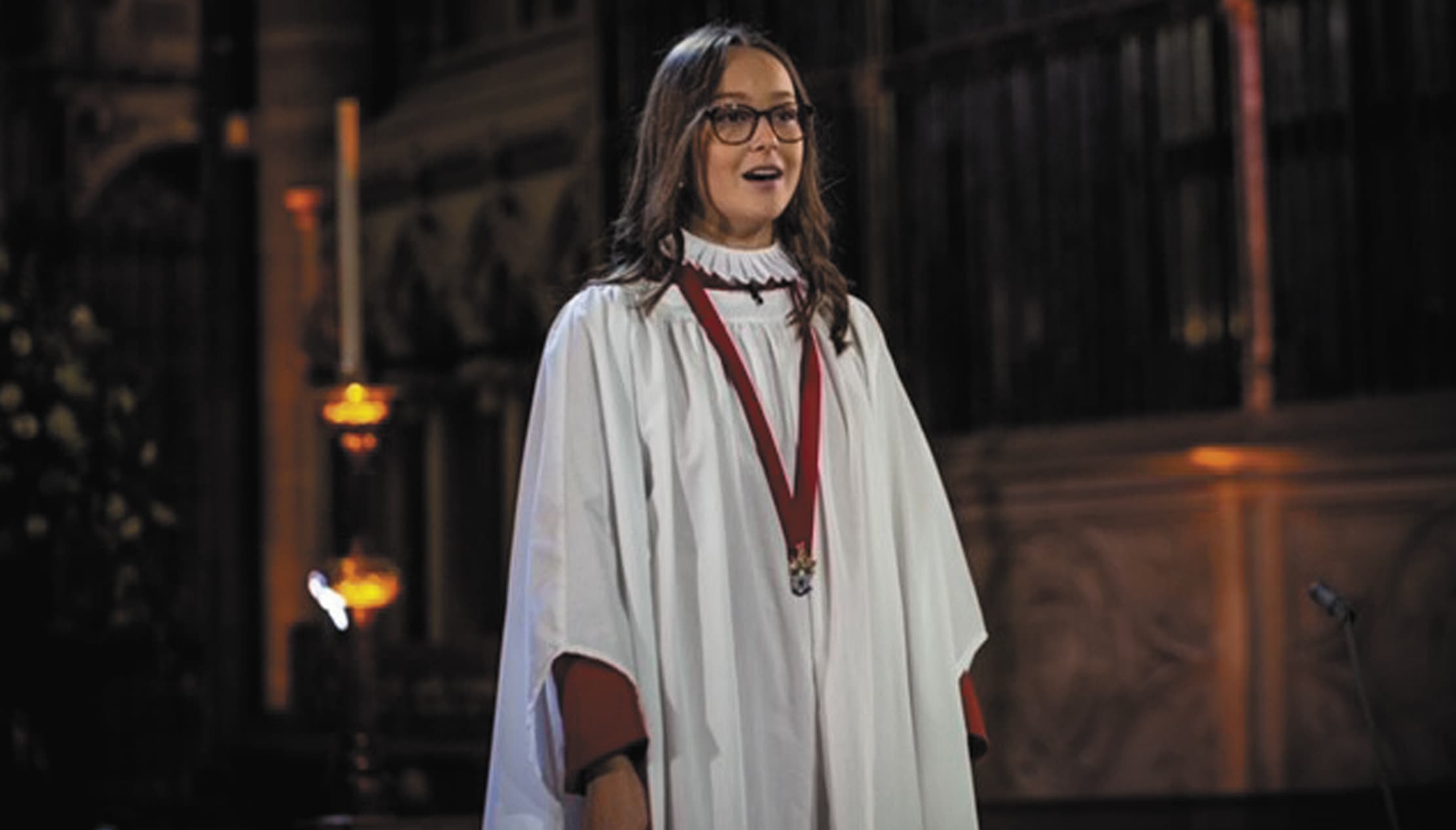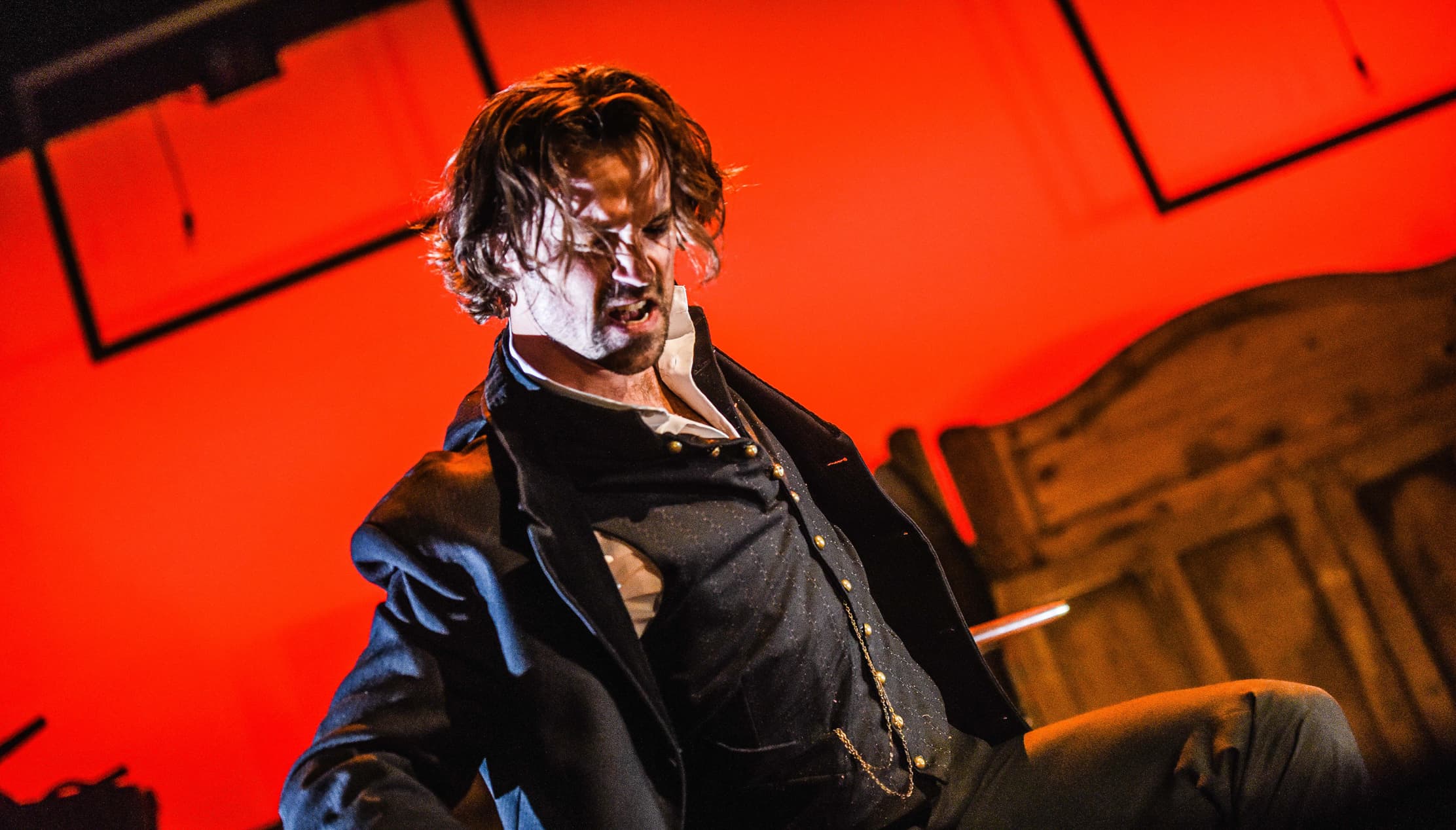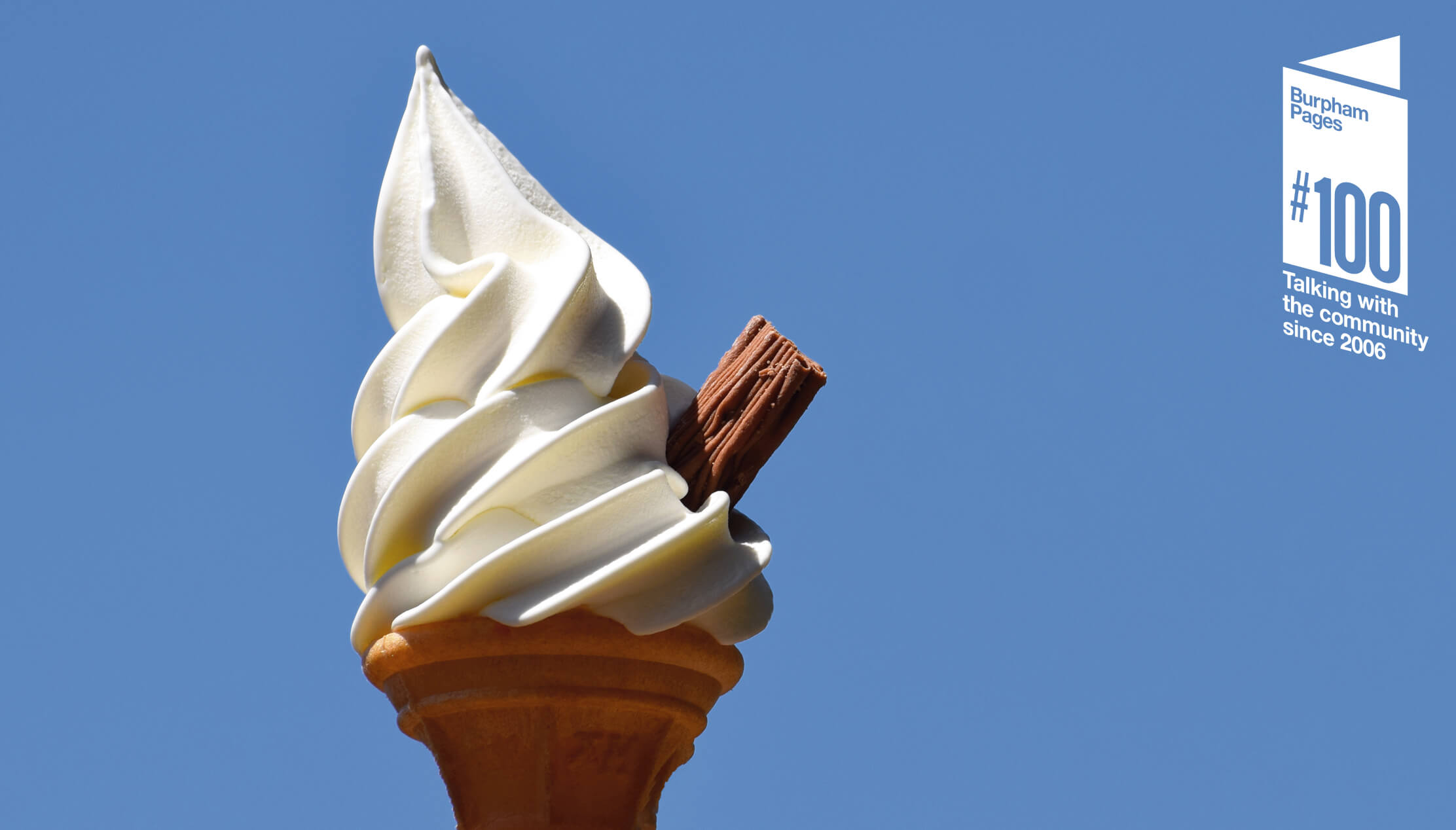Burpham Community Association: Committee Changes

Liz Critchfield has retired as BCA Secretary after ten years of high quality work on behalf of the people of Burpham. Although she will be a very hard act to follow, the BCA desperately needs volunteers to enable this work to continue.
For the time being, the secretary’s responsibilities will be shared by the remaining members as so far no one has come forward to take the job on. Please be assured that someone will respond to any emails, telephone calls or letters. The email address remains the same (secretary@burphamca.org.uk) but the contact telephone number has changed to 07513 366072 and the address if you wish to write, is Burpham Community Association, 6 Darfield Road, Burpham, GU7 7YY.
Girl Chorister at Guildford Cathedral wins BBC Young Chorister of the Year 2021

Guildford Cathedral is delighted to announce that a member of the Girl Choristers, Ruby has won the prestigious joint BBC Radio 2 and Songs of Praise Young Chorister of the Year 2021.
The final, held in Salisbury Cathedral, was broadcast on BBC 1 at 12.30 pm on Sunday 5 December and on BBC Radio 2 at 7.00pm.
The programme was hosted by Songs of Praise presenter, Aled Jones, and the panel of expert judges – Lesley Garrett, Howard Goodall, and David Grant – selected the winner and the runner-up.
Ruby said, on winning the final: “I still can’t believe I won. I feel very lucky and have loved every minute. I’m so excited for the future. Huge thank you to all those who have supported me, especially Katherine.”
Katherine Dienes-Williams, Organist and Master of the Choristers of Guildford Cathedral said ‘We are all hugely proud of Ruby and are delighted to celebrate her fabulous achievement.
Congratulations to her and to all the competitors and thank you to all who have supported her on this journey. We look forward to continuing to enjoy her singing here at the Cathedral on a regular basis.
“I still can’t believe I won. I feel very lucky and have loved every minute. I’m so excited for the future. Huge thank you to all those who have supported me, especially Katherine.”
In summing up the competition, the judges gave Ruby glowing comments. David Grant said: “It was translucently brilliant”. Lesley Garrett said: “She’s got this fantastically free, powerful, gorgeous lyrical sound.”, while Howard Goodall, on making the announcement that Ruby was the winner said: “In a very, very tight field we felt that this singer gave a performance that was truly outstanding and flawless.“
When thinking of which Christmas Carol to sing for the final of the BBC Young Chorister of the Year, Ruby was very keen to sing ‘The Shepherds Sing’ by renowned composer and former Kings singer, Bob Chilcott. However, the piece only existed in a four-part choir version. The Cathedral reached out to Bob who very kindly made an arrangement of his own piece for solo voice specifically for Ruby to sing! Huge thanks must go to him for this generous gift.
The Strange Case of Dr Jekyll and Mr Hyde at the Yvonne Arnaud Theatre
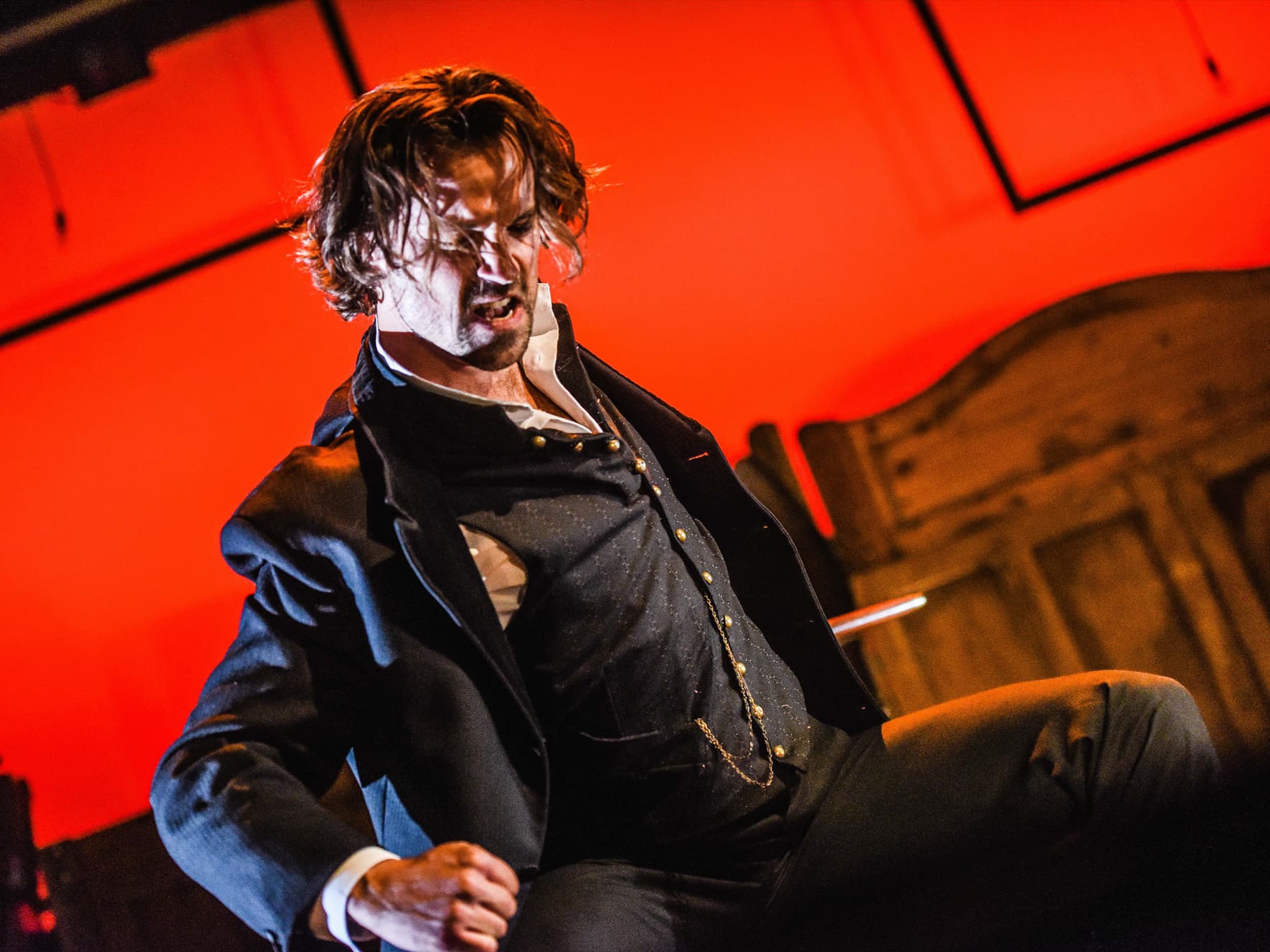
From the 1st – 5th of February the Blackeyed Theatre, in association with South Hill Park, bring their thrilling adaptation of Robert Louis Stevenson’s dark psychological fantasy, The Strange Case of Dr Jekyll and Mr Hyde to the Yvonne Arnaud Theatre.
Doctor Henry Jekyll is a good man. Successful within his field and respected by his peers, he’s close to a neurological discovery that will change the face of medical science forever. However, his methods are less than ethical, and when a close friend and colleague threatens to expose and destroy his work, Jekyll is forced to experiment on himself, whereupon something goes very wrong… or very right. And suddenly Jekyll has a new friend, the brutal Edward Hyde.
One of the great classics of British literature brought to life on the stage, this adaptation of the iconic Gothic novella revives the compelling characters and riveting moral dilemmas of Robert Louis Stevenson’s The Strange Case of Dr Jekyll and Mr Hyde.
Immerse yourself in the myth and mystery of 19th century London’s fog-bound streets where love, betrayal and murder lurk at every chilling twist and turn. Gripping, stylish and thought-provoking, this is unmissable theatre. Go on… treat your dark side!
For more information and to book tickets, visit: www.yvonne-arnaud.co.uk. Alternatively, contact the Box Office on 01483 440 000 (Mon-Fri, 10am to 5pm).
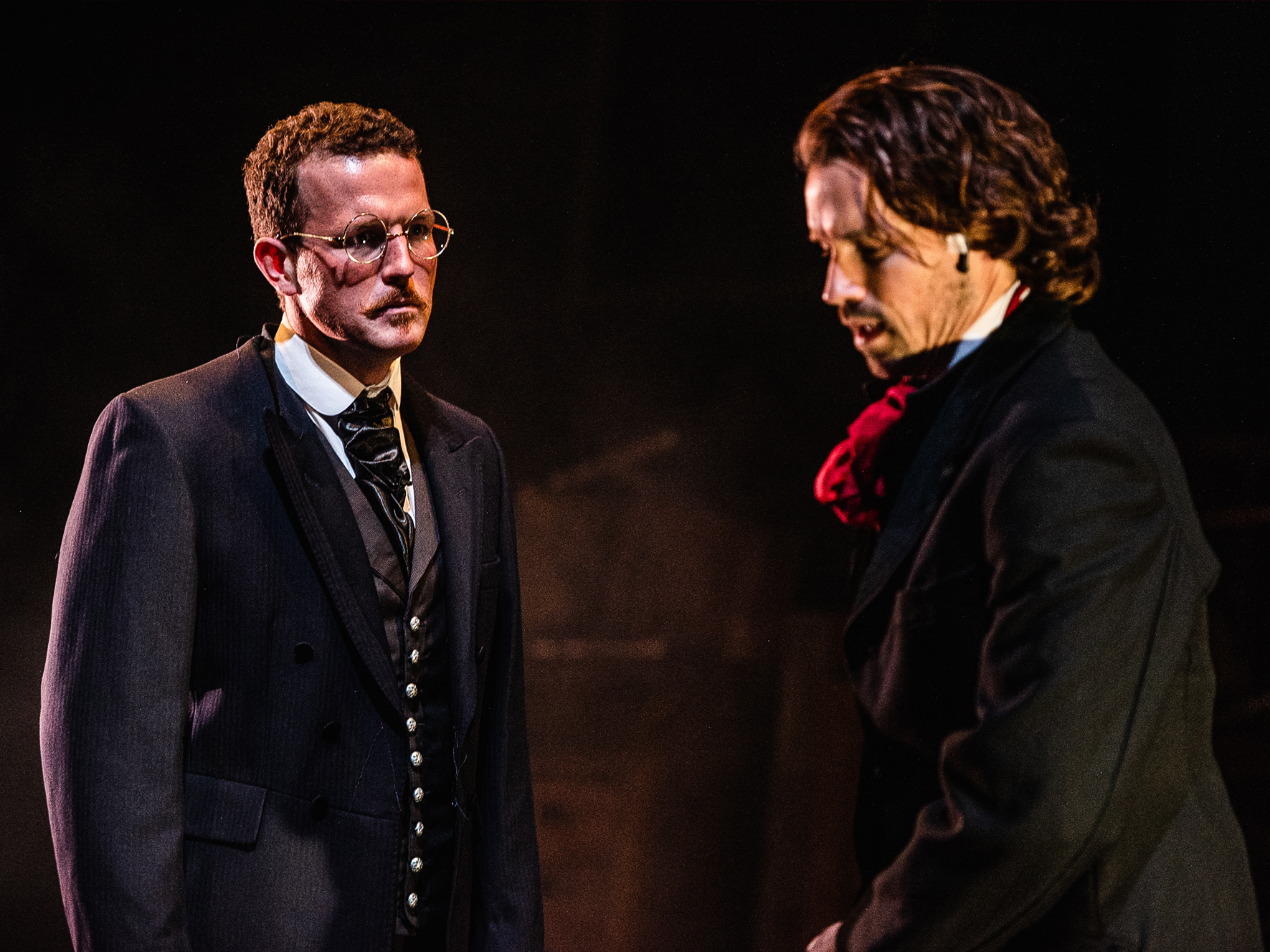
St Luke’s Church
Moira MacQuaide’s history of Burpham
Prior to 1859, there was no church at all in Burpham, which was part of the Parish of Worplesdon, so residents had to travel to St Mary’s to attend services. The people of Burpham decided that they needed a church and burying place of their own.
Lord Onslow donated the site and funds were raised, headed by patrons in Worplesdon and the Provost and Fellows of Eton College. The architect was Mr Woodyer of Graffham and the builder was Mr William Swayne of Stoke Road. Work began in August 1858 and the whole church was built for less than £1,000. On 24th May 1859 the Lord Bishop of Winchester came for the consecration of St Luke’s as a Chapel of Ease to St Mary’s Worplesdon. At last farm workers and their families could attend their own local church.
It is a small church, with a vestry on the north side. The walls are of Bargate stone and the window and door facings made from Bath stone. The oak pulpit was purchased from a parish in Bristol for £10 in 1958, replacing the original chalk stone pulpit. There used to be a pipe organ, but this has since been replaced with an electronic one. The porch was added in 1961, given by Mr & Mrs Howard. Electricity was installed in the 1930s and some renovations were done before the centenary in 1959.
The first child to be baptised at St Luke’s was Lucy Chapman, in July 1859, and the first burial was a two-year old child, Edward James Alexander, in June 1859. In 1920 Burpham broke away from Worplesdon, joining instead with St Peter’s Old Woking. St Luke’s became a parish church in its own right in 1954 and in 1921 the church was licensed for the solemnization of marriages.
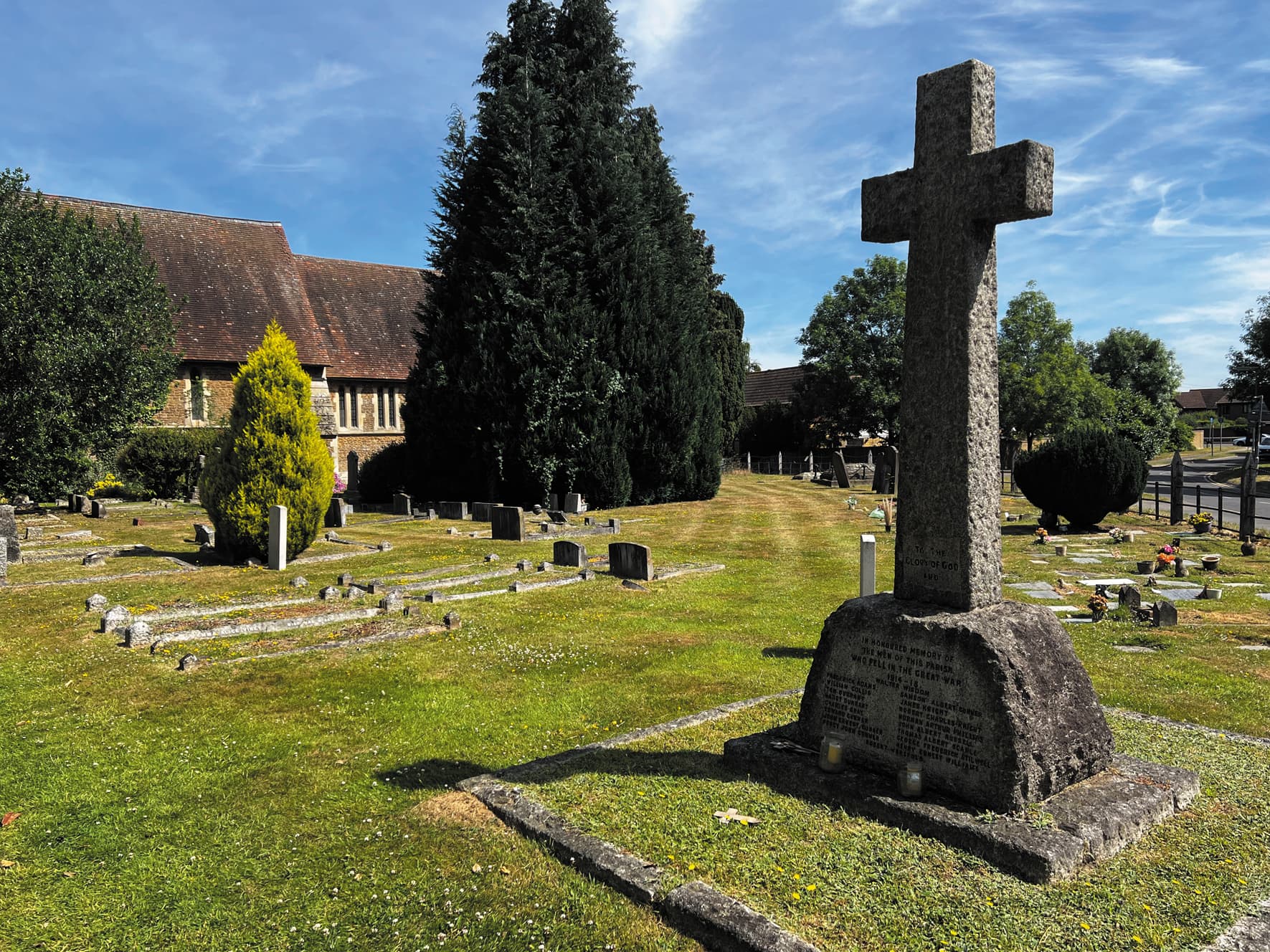
The War Memorial is just inside the main gate to the church, commemorating those in the community who lost their lives in both World Wars – 18 in the first and 11 in the second.
In 1857 a conveyance between the Duke of Sutherland and the Church Commissioners set out arrangements for a new vicarage on Burpham Lane, opposite the Primary School, now the home of a nursery school. Since then the vicarage has moved to Orchard Road and is currently on London Road. In 1959 the community celebrated the centenary of the church, with a range of events held that summer and autumn.
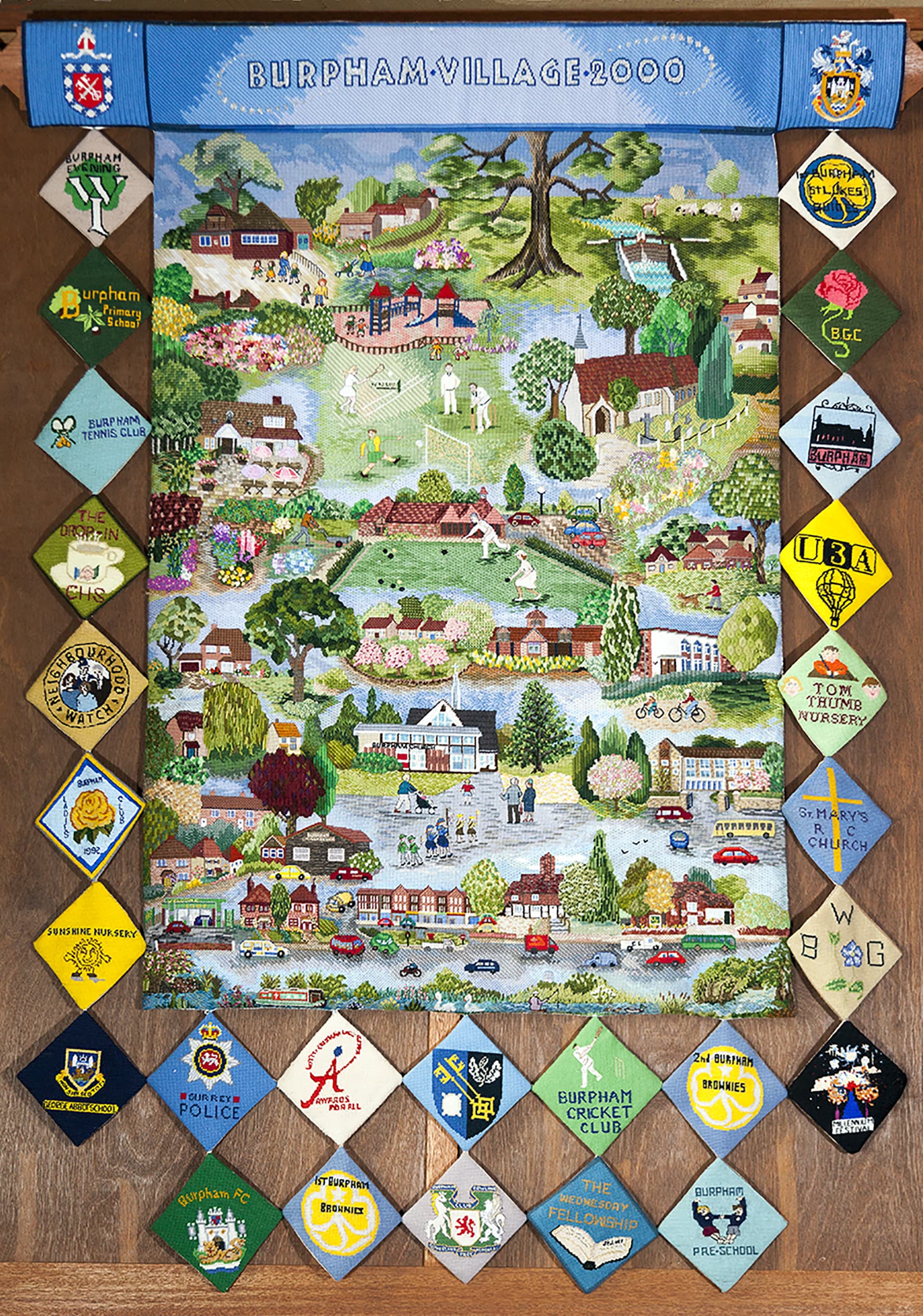
The Burpham Tapestry, created as part of the Millennium celebrations, is displayed on a wall in the church. For many years the children of Burpham Primary School held their Christmas Carol Service in St Luke’s, where the acoustics are excellent, until space ran out and they had to move to a bigger venue. The church is one of the oldest buildings in Burpham.
If you are willing to share your memories and/or photos to tell us more about Burpham then please contact Moira MacQuaide, either by e-mail (moira.macquaide@gmail.com) or by phone or text (07963 756543). My two books (‘The History of Burpham Primary School’ and ‘Burpham – A Gateway to Guildford’) are still available from me for £10 (free delivery locally) or on Amazon.
What comes to mind when you think of one hundred?
I wonder what comes to mind when you think of one hundred. Is it an age you’d love to reach and get that special card from the Queen? Is it the top mark in your exam, 100/100, however hard that may be to obtain? Or is it a definitive exclamation – Yes I’m in, 100%!
What do you think of? When I think of one hundred, I think of sheep and melting ice cream. Not just the counting-sheep-to-fall-asleep so the bags beneath my eyes don’t make me look like a hundred-year-old in the morning – although I did once read that to fall asleep you just need to count backwards from one hundred and by the time you have done it three times, you will be asleep. To be honest though, I usually get distracted before
I ever get back to one.
However, let us return to the one hundred sheep (I shall keep the ice cream until later). Sheep: fluffy, noisy sheep out on a Jewish hillside with their shepherd. Perhaps you know where I am going with this, for Jesus tells one of his best loved parables about a shepherd with a hundred sheep. And one of the sheep is missing.
Ninety nine all present and correct, one sheep missing. Not a big deal? It’s only a 1% loss. Should be expected. Would you head off home and not worry? In Jesus’ story, the farmer does the opposite and beyond, leaving the ninety-nine out on the hillside and heading off in search of the one missing sheep. In our wonderfully illustrated children’s version, we go on a long journey looking in all sorts of places, over the hill and across the river, before finally we find the sheep stuck somewhere in a tangle of briars. And just as Jesus tells it, when he finds the absent sheep, the farmer joyfully puts it on his shoulders and returns home to celebrate with his neighbours – for his lost sheep was found.
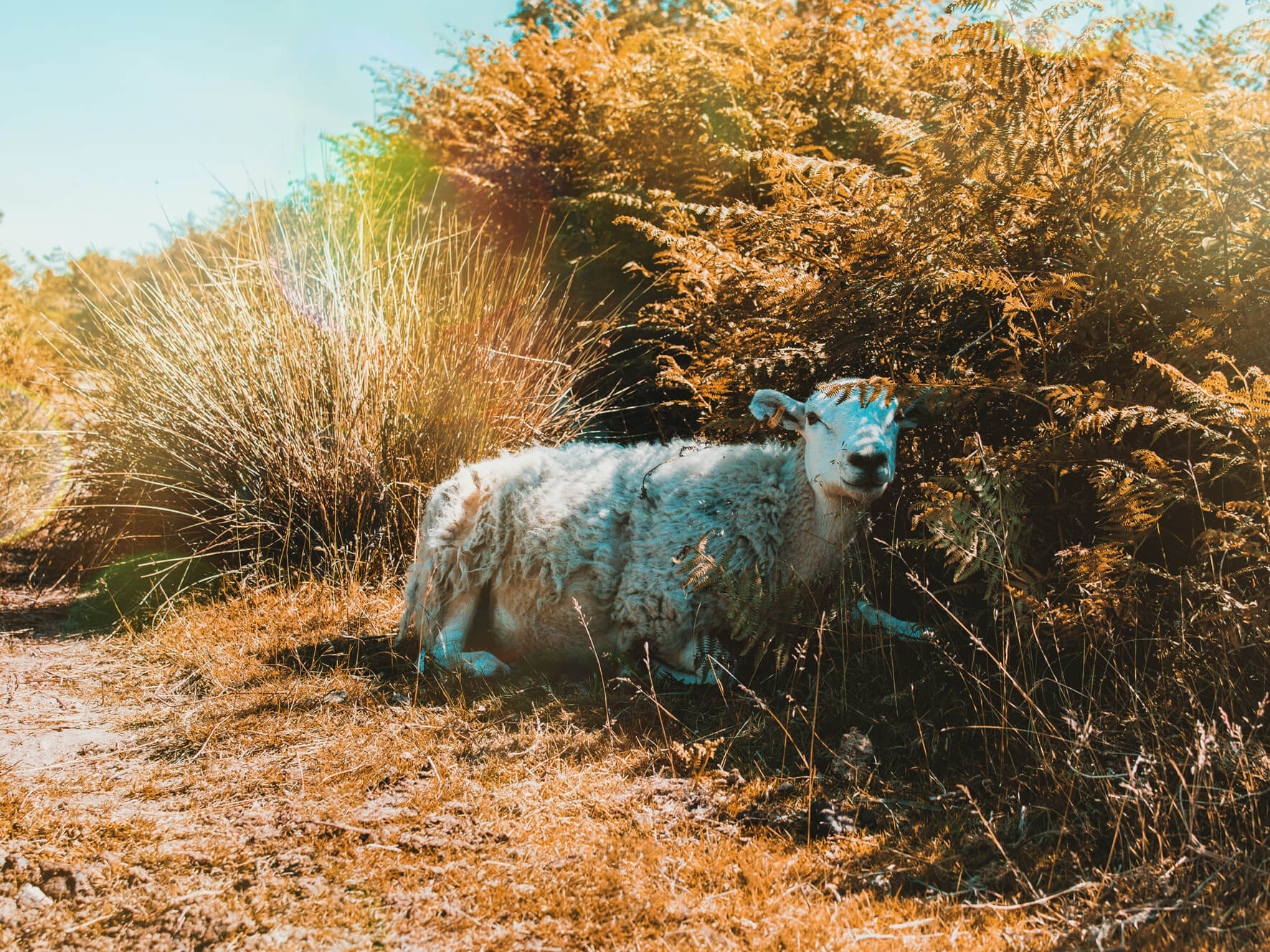
So where does that leave us in our one hundredth issue this month here in Burpham? Well certainly with a new take on ice cream. Will you ever be able to look at an ’99 ice cream cone in the same way? I can’t!
Rev’d Joanna Levasier
No mention of the ninety-nine left on the hill (that’s where the melting ice cream comes in… he left the ’99 – a bad pun for which I apologise deeply… memorable though). Sadly, there was no ice cream in Jesus’ version – just a farmer ecstatic about one lost sheep who is now found. And Jesus’ punchline for the listening audience – that’s how God feels about one person on the outside who finds him. God would gladly leave waiting on the hill ninety-nine people who’ve already found him, ninety-nine people already sitting in church, ninety-nine people who’ve already discovered peace and purpose in Him. God is much more bothered about the one wandering about lost on the hill somewhere. These are the ones for whom he was, and is, searching for.
And the Christian God is the same yesterday, today and forever. That means God is still much more bothered about those of us who feel lost, wandering around confused or uncertain, unclear where we are going and what we should be doing, than those who are sitting in church on Sunday already. God is passionate about everyone – and especially those of us who feel like we are on the outside, unwelcome and lost. God is especially keen to be looking out for everyone who feels excluded, unwanted and lost, rather than those who think they’ve got it all sorted.
So where does that leave us in our one hundredth issue this month here in Burpham? Well certainly with a new take on ice cream. Will you ever be able to look at an ’99 ice cream cone in the same way? I can’t!
But more seriously, whether you feel the age one hundred is approaching far too soon, or the exam results are so far below one hundred percent or frankly you don’t feel “all in” about anything these days – God is passionate about you, and I mean PASSIONATE. He would dump all the churches in Guildford in an instant to find you.
Perhaps that’s a different way to look at one hundred. Beats a melting ’99 any day.
With every blessing
Rev’d Jo Levasier
jo@burphamchurch.org.uk

Church Office: 01483 825533
www.burphamchurch.org.uk
Burpham Afternoon Women’s Institute (WI)
Moira MacQuaide’s history of Burpham
The WI came to Britain in 1915 from Canada, and in 1931 the women of Burpham opened their own branch as an afternoon meeting.
At the time most married women stayed at home as wives and mothers, so it was a great opportunity to get out of the house and mix with others of like mind. The founder members included the Hon. Mrs Hopewell, Mrs Bidwell, Mrs Berry, Mrs Marshall and Mrs Grover, as well as Mrs Gatley, Mrs Andrews, Mrs Binsted, Mrs Sturgess and Mrs Sheppard.
The WI has a long history of fund-raising, education for women and lifelong friendships. In 1936 the Yorkshire Evening Post reported that “Burpham Surrey Women’s Institute decided, after a debate, that married women have a better time than single women”. In 1939 the Surrey Advertiser reported that “the choir gave a very spirited performance of old songs”; also that Mrs Braybrooke won the potato competition with one of 26lbs. They ran jumble sales and outings, as well as organising Christmas parties for the village.
The ladies were kept busy during the war, making swabs for the local hospital, or marmalade. There were collections of baby clothes and prams for the evacuated mothers staying at Gosden House, and toys for the evacuated children.
“Burpham Surrey Women’s Institute decided, after a debate, that married women have a better time than single women”.
Yorkshire Evening Post, 1936
Social activities continued, but were often interrupted due to air raids. In the days before the NHS the WI members would collect eggs, vegetables and potatoes for local hospitals. After the war, life returned to normality and records show that WI meetings would begin with everyone singing Jerusalem, the WI song, and minutes reported the Chairlady saying “and so ended another interesting and happy meeting”.
In 1952 there was a minute’s silence in memory of the late King George VI, followed by singing the National Anthem. In 1953 members went on a coach trip to London, to see the Coronation illuminations. They were asked to make flowers for the Civic Restaurant, and were invited to the Coronation celebrations at Sutton Green. In 1954 the WI was asked to help provide for a playing field in Burpham, so they raised money at social events and ran a stall as part of the fete for the Grand Opening in 1956.
The WI had a drama group, which put on plays in the village hall. In 1964, as part of the 33rd birthday celebrations for the branch, money was raised for Burpham Homes and the Betatron Appeal for St Luke’s Hospital. In 1965 the National Federation celebrated the Golden Jubilee and Mrs Joan Petry was invited to represent Burpham at a Royal Garden Party at Buckingham Palace.
The current Burpham Evening WI started in 1989, to reflect the changes of modern life, with more women out at work during the day. By 1991 the Afternoon WI closed down, when they were unable to enlist a new Treasurer, having been an important part of the village for 60 years. However, the Evening WI continues to thrive in the Burpham community.
If you are willing to share your memories and/or photos to tell us more about Burpham then please contact Moira MacQuaide, either by e-mail (moira.macquaide@gmail.com) or by phone or text (07963 756543). My two books (‘The History of Burpham Primary School’ and ‘Burpham – A Gateway to Guildford’) are still available from me for £10 (free delivery locally) or on Amazon.
Burpham During the Second World War
Moira MacQuaide’s history of Burpham
As we approach Remembrance Day in 2021, it’s worth looking back to see how life in Burpham was remembered by residents. Then, as now, everyone was affected by changes to daily life, much of which was totally out of their control. The village was very different to now, with working farms along both sides of the London Road and fewer houses.
Burpham Primary School started changing in 1939 when trenches were dug in the grounds to provide air raid shelters, but these were useless as they filled with rain water, and it wasn’t until late 1940 that a proper concrete shelter was installed – Jean Menzies remembered playing Hangman in there. The school doubled in size to 62, when evacuated children from Fulham arrived as part of Operation Pied Piper, living with local families.
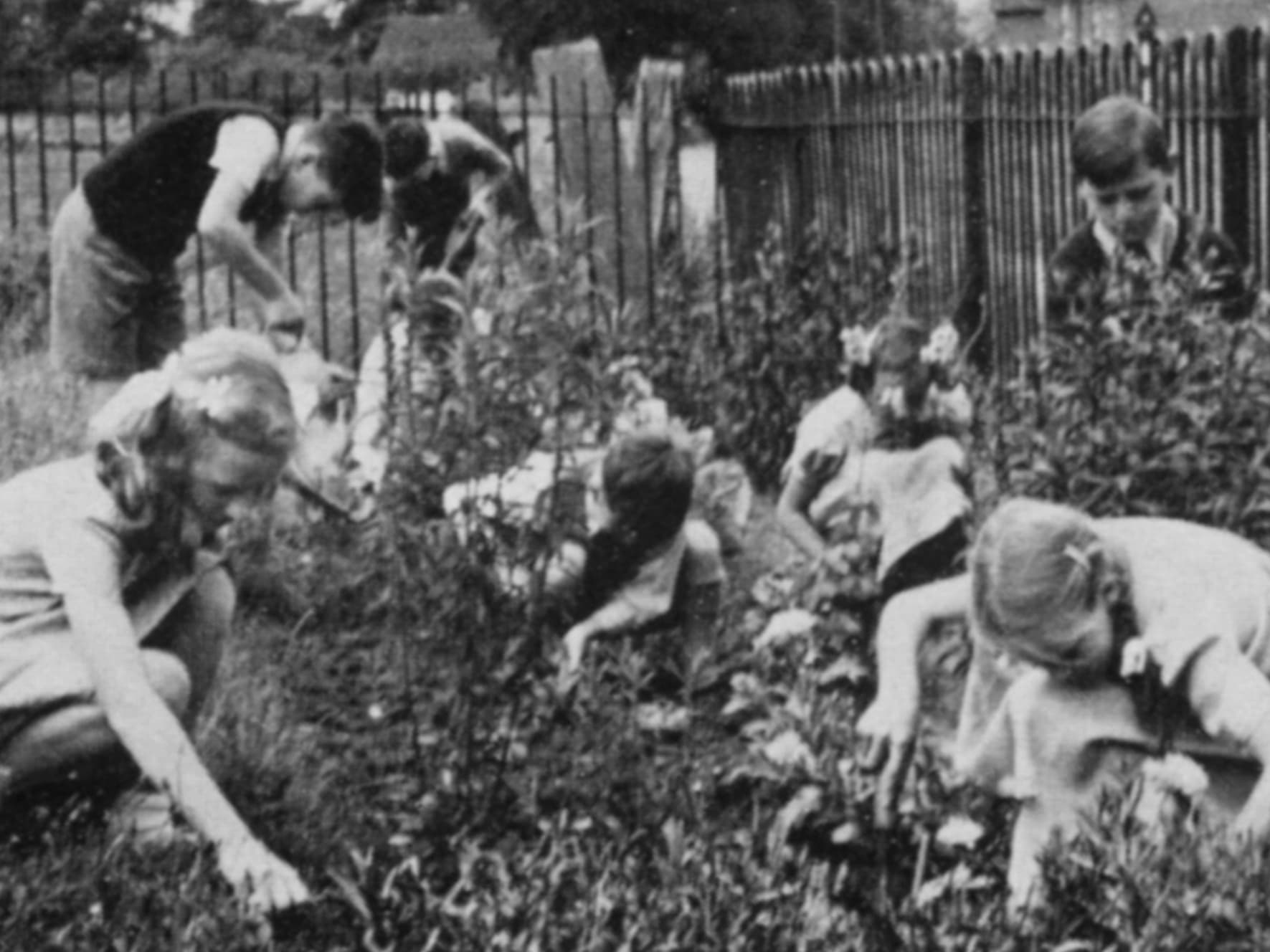
Many were amazed at being in a rural area, with farmland, animals, trees and flowers abounding. Miss Chesterfield arrived in 1940 to be the Headmistress, becoming the longest serving teacher in the school’s history. Children planted vegetables as part of the Dig for Victory campaign, and enjoyed the chocolate powder sent from Canada for them to take home – dipping their fingers in it on the way. The Surrey Emergency Committee tried to requisition the iron railings around the perimeter of the school, to be melted down for munitions, but they faced the full force of Miss Chesterfield’s disapproval and the railings are still there today. Miss Lugsden and Miss Pratt also joined the school during the war years, and all three teachers retired in the early 1970s.
The Burpham air raid siren was at the Kingpost, being a central point for the village but, although the school could hear the siren telling them to go to the air raid shelter, they couldn’t hear the all-clear one telling them to come out!

Mr Nobes, the publican of the Green Man, was told by the Food Office that two churns of milk would be provided for the evacuee children who were travelling from London. Pat Ward, his daughter, remembered that the pub had been a centre for family gatherings, but war broke up families. Also, it was difficult to get supplies as the pub was allocated gin and whisky on the basis of pre-war requirements, despite it being busier during the war.
The pub kept lots of chickens, which provided eggs and meat. They didn’t take in any evacuee children because they sold alcohol in the pub. She said that the Government was keen to keep the London Road open, in case the rail line was bombed.
Barbara Stone remembered that a bomb went off near the bridge on New Inn Lane, presumably intended for the railway, and the roof of her house was lifted up and back down, leaving broken windows and cracks in walls. Her father, Valentine Gow, worked for Cow & Gate and was responsible for ensuring that factories had all the necessary parts to keep going, so he had to travel round the country – he invented the first milk bottle washing machine. He was also in the Home Guard. She also remembered all the children were issued with gas masks and hers had a Mickey Mouse face in red and blue.
The Home Guard B Company set up its HQ at the Green Man, meeting in the Function Room in the Paddock Rooms. One of their duties was going out at night to check that houses had blackout curtains at their windows. Captain EH Shepard, who illustrated Winnie the Pooh books, was second in command of the Battalion in 1942. At the end of the war, members of the Home Guard were sent a letter from King George VI, thanking them for their time and effort. There was a Prisoner of War camp in Merrow, where many prisoners were kept – some of the Italian prisoners worked on Gosden Hill Farm, making baskets to sell, while some German prisoners worked at cutting hedges.
Fundraising was important and various social events were organised by the Burpham Women’s Institute, in aid of projects such as the Salute the Soldier Week. Children collected National Savings Stamps, which raised funds for War Weapons Week.
Leo Keene, who farmed Gosden Hill Farm, served with the Milk Marketing Board during the war, ensuring that milk was available where it was needed, especially for schools. The farm provided accommodation for girls from the ATS, WRAF and WRNS, who would pay for board & lodging with food coupons. Farm workers were usually reserved occupations, so they could continue providing food to the community.
The London Road was busy with military vehicles travelling back and forth, including lots of tanks. Also, American soldiers came through Burpham and threw sweets to the children as they went past.
The St Luke’s War Memorial on Burpham Lane shows the names of the 11 men who lost their lives in WW2. Many of their fathers served with the Home Guard. All but three of those who died were under 25 years old – so young to die.
- Aubrey Collins of Hawthorne Way
- James Cross of London Road
- Norman Drake of Orchard Road
- Jack Dunn of Meadow Road
- Clive Hammond of Jacob’s Well
- Harry Hirst of Orchard Road
- Derek Lord of Orchard Road
- Kenneth Percival of Paddocks Road
- Frederick Ranger of Winterhill Way
- Samuel Reid of Burpham Lane
- Peter Vickers of Orchard Road
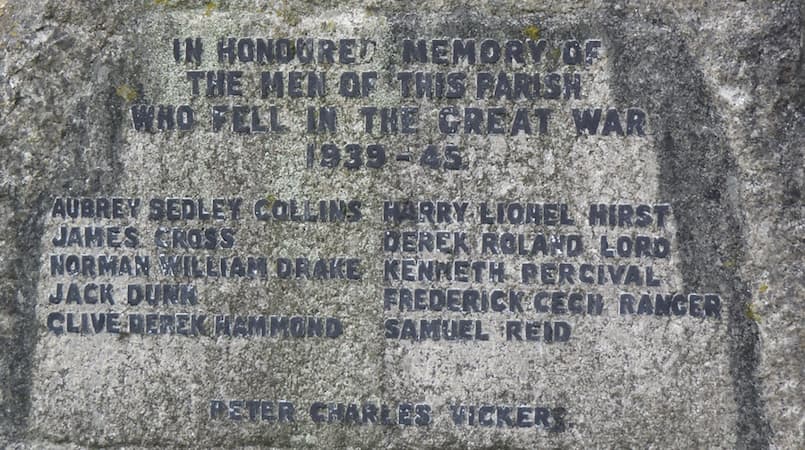
Many others from the village served in the forces and came home after the war.
War time was challenging for most people. Rationing of food, coupons to buy clothes, air raid shelters in the garden, blackouts in the house, and watching the planes fighting in the sky. So many people, in the forces and a range of other occupations, made it possible for most of our parents and grandparents to get through those difficult years.
The Duke and Duchess of Sutherland held a garden party at Sutton Place in June 1945, to celebrate the end of the war in Europe. Many Burpham residents were invited to this. Street parties were held around the country, but the only image found for Burpham was of Merrow Lane children gathered for their party.
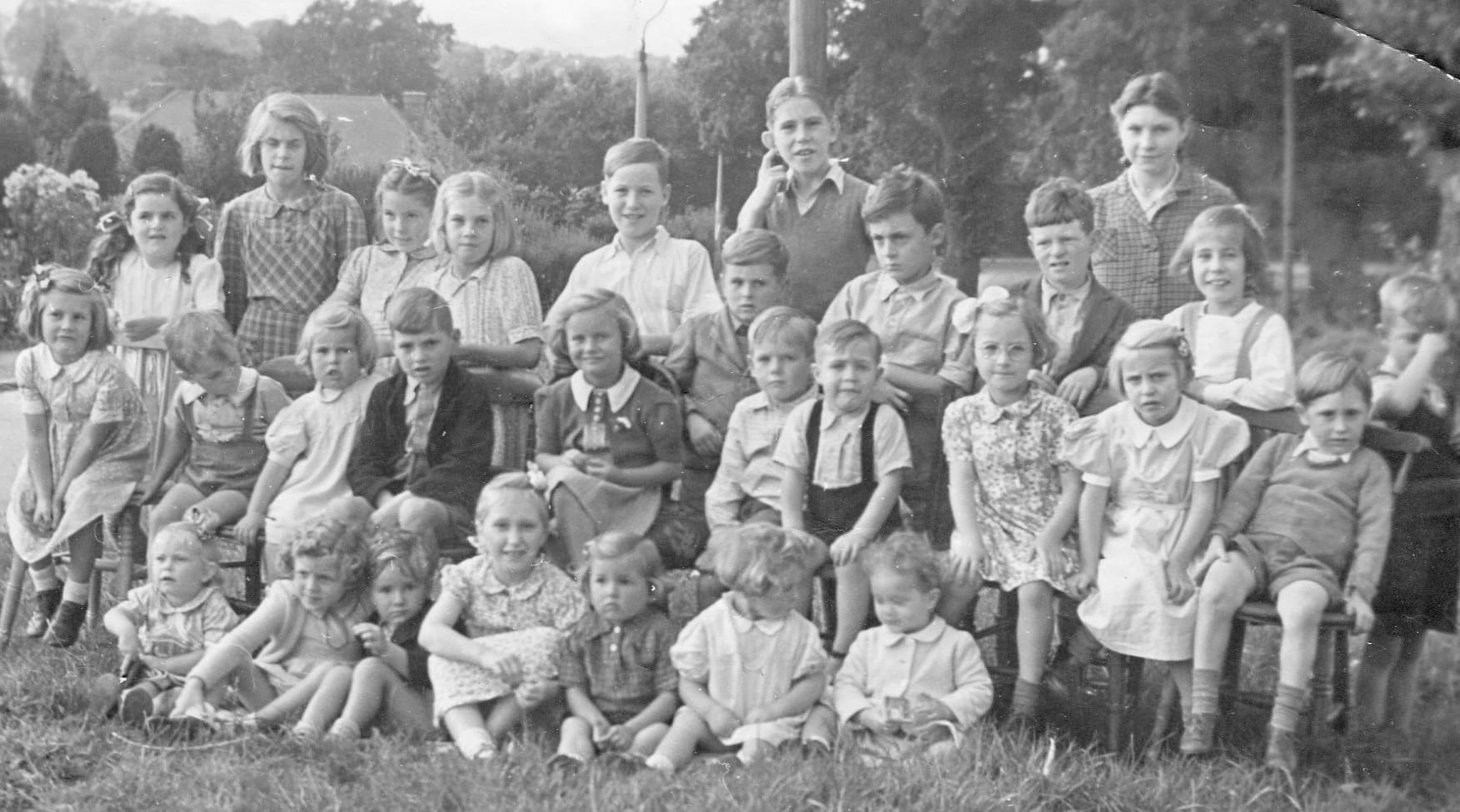
If you are willing to share your memories and/or photos to tell us more about Burpham then please contact Moira MacQuaide, either by e-mail (moira.macquaide@gmail.com) or by phone or text (07963 756543). My two books (‘The History of Burpham Primary School’ and ‘Burpham – A Gateway to Guildford’) are still available from me for £10 (free delivery locally) or on Amazon.
The ‘Attfield alias Ripley’ family
Moira MacQuaide’s history of Burpham
Sometimes it is possible to find a family that lived in a community for not only decades, but centuries. The ‘Attfield alias Ripley’ family is one of these. Whilst Attfield was originally ‘At-the-fields’, later ‘Atte Felde’ or ‘Atefeld’ it’s not known where the ‘alias’ extension of the name originated, but variations (and there are many different ones) could date back to Saxon times.
It’s possible that one of the surnames was adopted as a condition of inheritance, or to show a relationship to a prominent local family. Research shows that most of this family lived in Surrey, and there are baptism records dating back to the 1500s at Worplesdon. Some of these early records show that the family lived in Burpham, which was then part of Worplesdon Parish. There are other records of the wider Attfield family in Farnham, Windlesham, Chobham and Egham. Here are just a few examples of the family, mainly from probate records:
Agnes Atffylde alias Rypley of Burgham, a widow, left an interesting will when she died in 1574. She left 12 dozen loaves, six cheeses and a kilderkin of beer for her wake, and money for the poor of Worplesdon and Merrow. Amongst a long list of bequests to family and servants, her godchildren received 6d each, a servant received various clothing and a calf, one of her sons received a bullock, some sheets, a chest, a pot and kettle, and some barley. The rest of her belongings went to her other sons.
In 1581 some land at Burpham, possibly around Pimm’s Row or near the Green Man, was transferred to Thomas Atfeild alias Ripley for 1,000 years, by Edmund Windsor of Hillesden, who had inherited the Lordship of the Manor of Burpham in 1566. When Thomas died he left the property to his wife, Alice.
Henry Attfeild alias Ripley died in 1629, leaving his house and land at Burpham Cross, presumably by the Green Man & possibly the Tudor cottages (now West Court), and land in Ganghill, to his son.
John Attfield alias Ripley died in 1754. He was the Victualler, or innkeeper, at the Green Man in Burpham, giving us the earliest record of the pub being in the village. He had three children, but he asked his cousin, Henry Attfield alias Ripley, to sell everything in order to pay for the children’s upkeep after his death.
In 1756 Thomas Atfield alias Ripley wanted his property at Hurst, now Burpham Court House and Willow Grange, to be sold in order to pay off his mortgage for Queenhithe Farm in Jacob’s Well, so that his wife could live there for the rest of her life.
By the 1841 census it seems that the family had left Burpham, though there were still members living in other parts of Worplesdon parish. Nowadays New Inn Farmhouse is the only building in Burpham that the Attfields would have known, but there are several still in Jacob’s Well.
The Attfield family are still researching their ancestors, and prior to the pandemic they held occasional reunions.
If you are willing to share your memories and/or photos to tell us more about Burpham then please contact Moira MacQuaide, either by e-mail (moira.macquaide@gmail.com) or by phone or text (07963 756543). My two books (‘The History of Burpham Primary School’ and ‘Burpham – A Gateway to Guildford’) are still available from me for £10 (free delivery locally) or on Amazon.
The streets of Burpham...
Moira MacQuaide’s history of Burpham
But it turned out that there are no streets! Roads, drives, lanes, ways, avenues, drives, etc, but no streets. 100 years ago there was only the London Road in Burpham, plus Burpham Lane, New Inn Lane, and Merrow Lane.
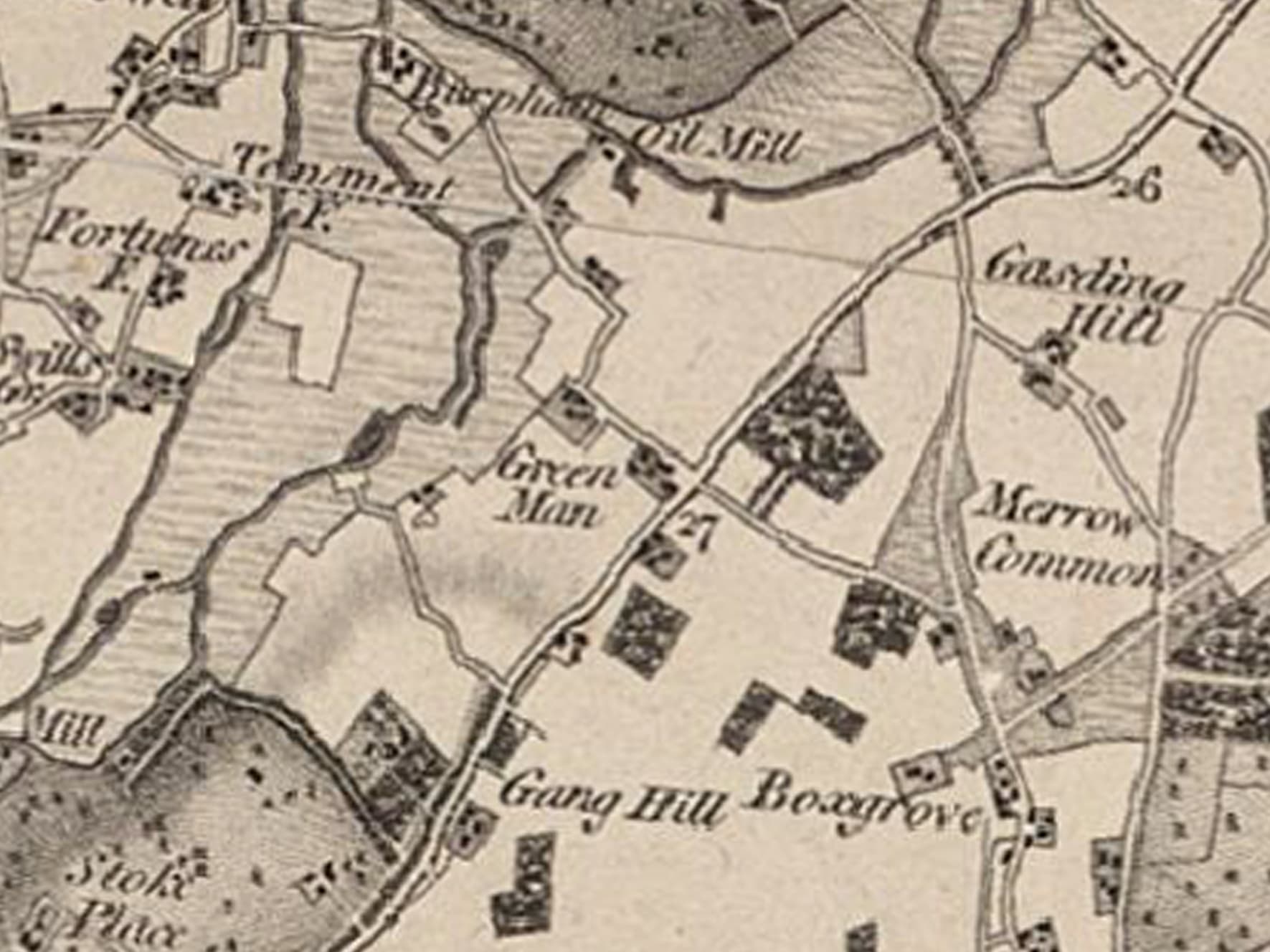
London Road was the main, and very busy, route from London to Portsmouth, but until the early 20th century Burpham was made up of farmland and not much else. Housing developments from the 1920s onwards have brought some large estates, including Winterhill, New Inn, Weylea and Bowers Farms.
The roads on the New Inn Farm estate, begun in the 1950s, are often referred to as the Herb Estate, with many old herb names such as Coltsfoot, Burnet, Bryony, Fennell and Woodruff. Whereas many roads on the Weylea Farm estate, built in the 1980s, are named after past residents of the village, such as Sutherland Drive (the Duke owned Bower’s Mill), Elkins Gardens (after the brewing family), Turner Close (William and Emma ran the village shop), Gatley Drive (George and Percy were farmers), Pimm’s Close (William was a farmer). Some refer to trees, such as Elder Close and The Cedars.
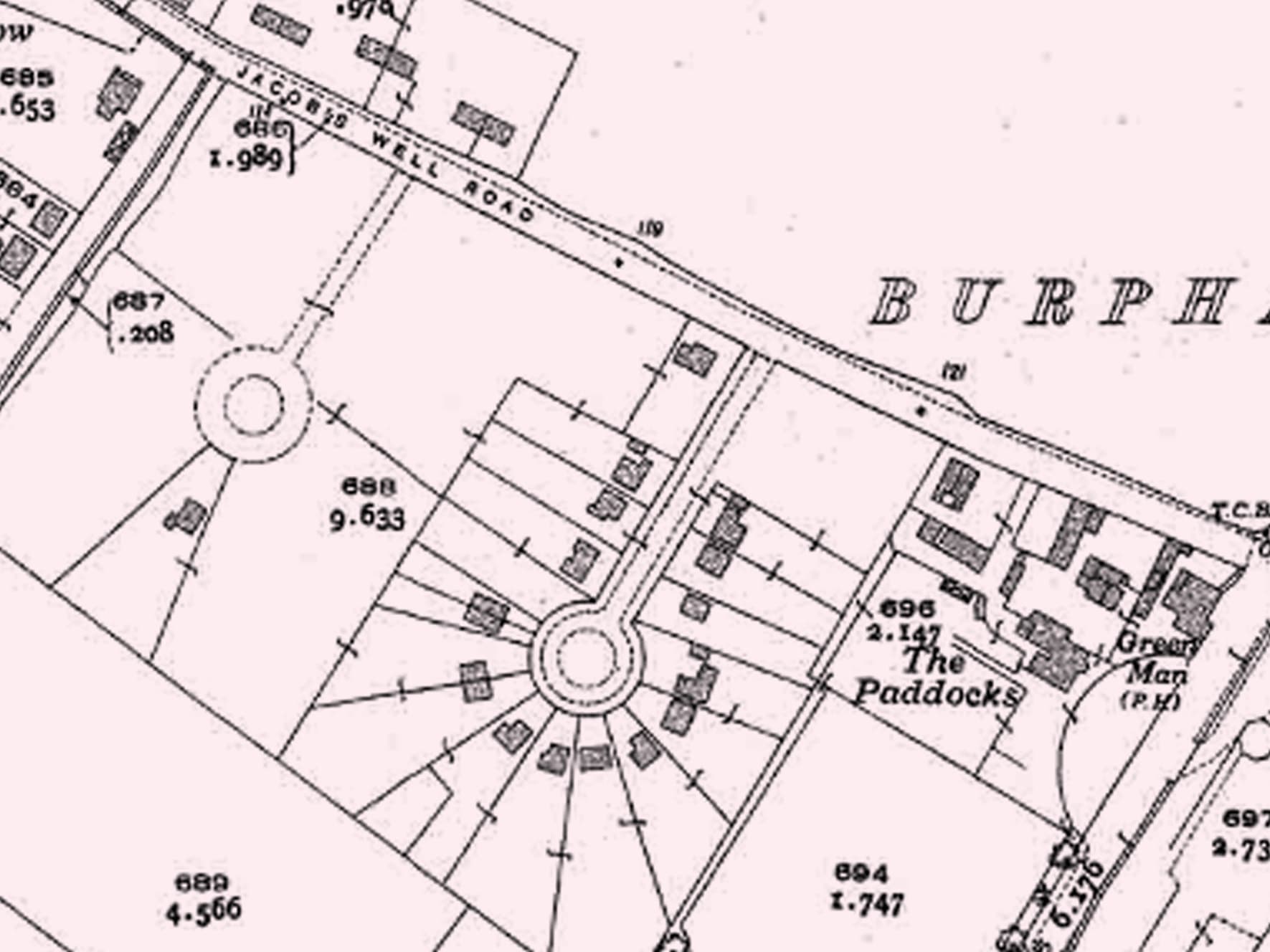
The Paddocks estate, Paddocks and Meadow Roads off Burpham Lane, was built in the 1920s, on the site of the Marlyn’s paddock and meadow. Further along is Howard Ridge, named after Roy and Percy, local builders. Clay Lane was built to replace the old Jacob’s Well Road, when the A3 was built, and refers to the heavy clay soil in the area. Bower’s Lane is part of the old road, now blocked for the A3 and after the hump-backed bridge, but giving access to Bower’s Mill.
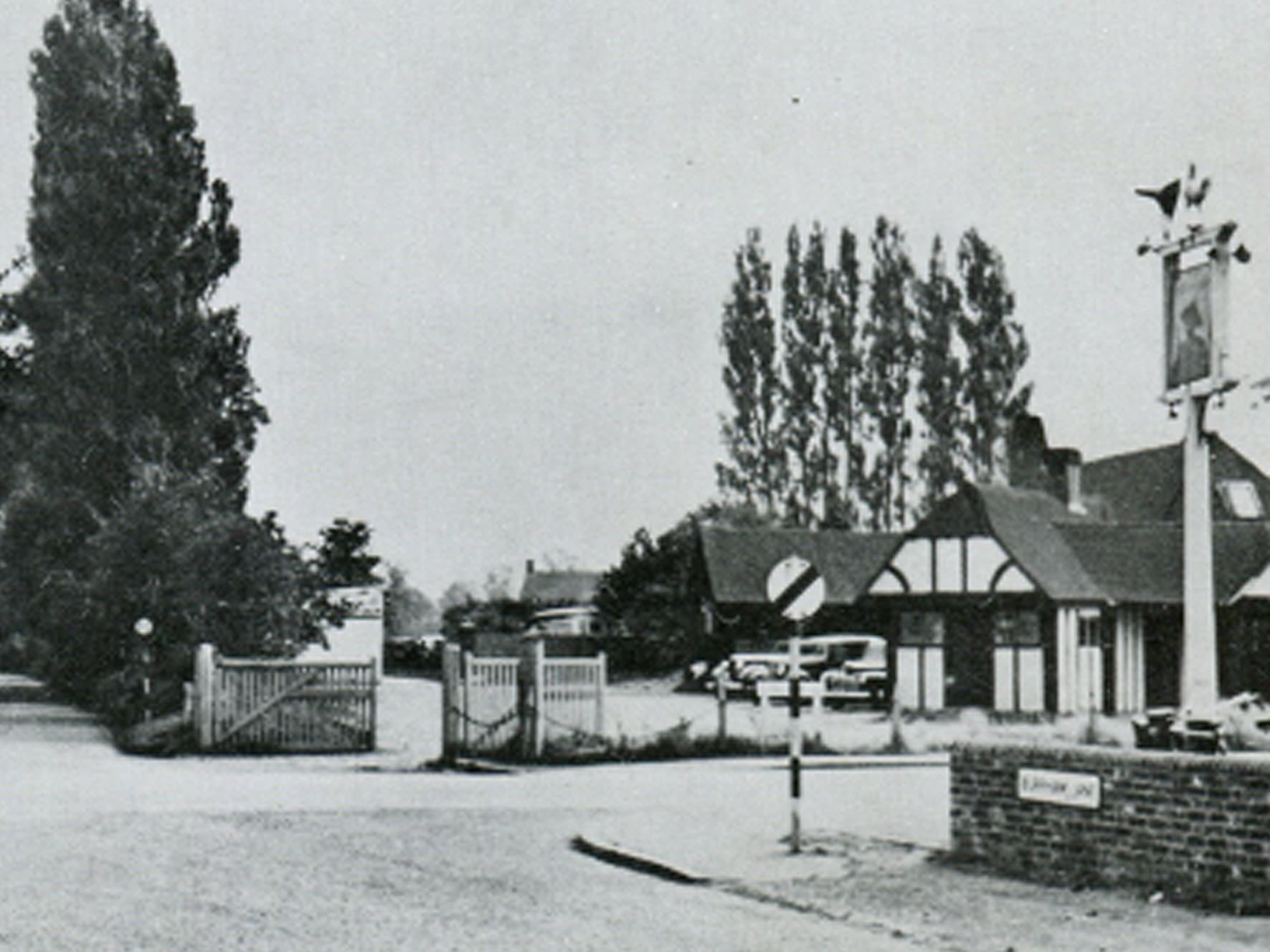
There were no houses on New Inn Lane until the late 1920s when Glendale Drive was developed as part of the Winterhill Farm estate and the old brick works. Several roads in the area reflect the local flora, such as Hawthorne and Briar Ways, Great Oaks Park, Oak Hill, Oak Tree Close and Orchard Road.
Weybrook Park is the newest of the large estates, many of the road names reflect the type of farming on Bower’s Farm such as Dairyman’s Walk and Jersey and Guernsey Closes. Some relate to local farms including Lady-grove, Whipley Manor, Tithebarn and Hazelhurst. Newark refers to the Priory at Ripley; Ockley and Abinger are local villages; Cotts Wood is near West Clandon. Watersmeet means where two rivers meet, so probably where the Merrow stream flows into the River Wey.
One of the most recent developments is Wroth Place, named after Robert Wroth, who was MP for Guildford in the early 1700s and Lord of the Manor for Burpham. He sold the village to Lord Onslow, but there doesn’t seem to be anything named after that family.
There are lots of road names in Burpham that I can’t identify their source, if you know what your road is named after, then please let me know moira.macquaide@gmail.com
If you are willing to share your memories and/or photos to tell us more about Burpham then please contact Moira MacQuaide, either by e-mail (moira.macquaide@gmail.com) or by phone or text (07963 756543). My two books (‘The History of Burpham Primary School’ and ‘Burpham – A Gateway to Guildford’) are still available from me for £10 (free delivery locally) or on Amazon.
Guildford ghosts & their stories
By Alex Rose
Although Halloween is behind us, the ghouls and ghosts of Guildford and its neighbouring towns still lurk. If you have a steady nerve, read on to hear their haunting stories.
For 20 years, ghost tours of Guildford have uncovered a darker side of the town centre to tourists and locals alike. In this article we’ll explore some of the most intriguing tales from our local area, including the chilling sightings of Guildford Castle, an unexplainable A3 apparition, the infamous legend of Silent Pool and more.
Nestled in the Surrey Hills – an area of outstanding beauty – lies Silent Pool near Shere, a well-known walker’s hotspot boasting a popular gin distillery company of the same name. The serene and mysterious Silent Pool is a spring-fed lake secluded by trees and shrouded in an eerie stillness said to be haunted by the presence of a woodcutter’s daughter. It was near here that Agatha Christie’s car was discovered whilst she was missing for eleven days before being discovered at a hotel in Harrogate with apparent memory loss, a mystery likened to her own novels. It was also here that the 19th century poet, Alfred Tennyson used to visit and muse over his poems.
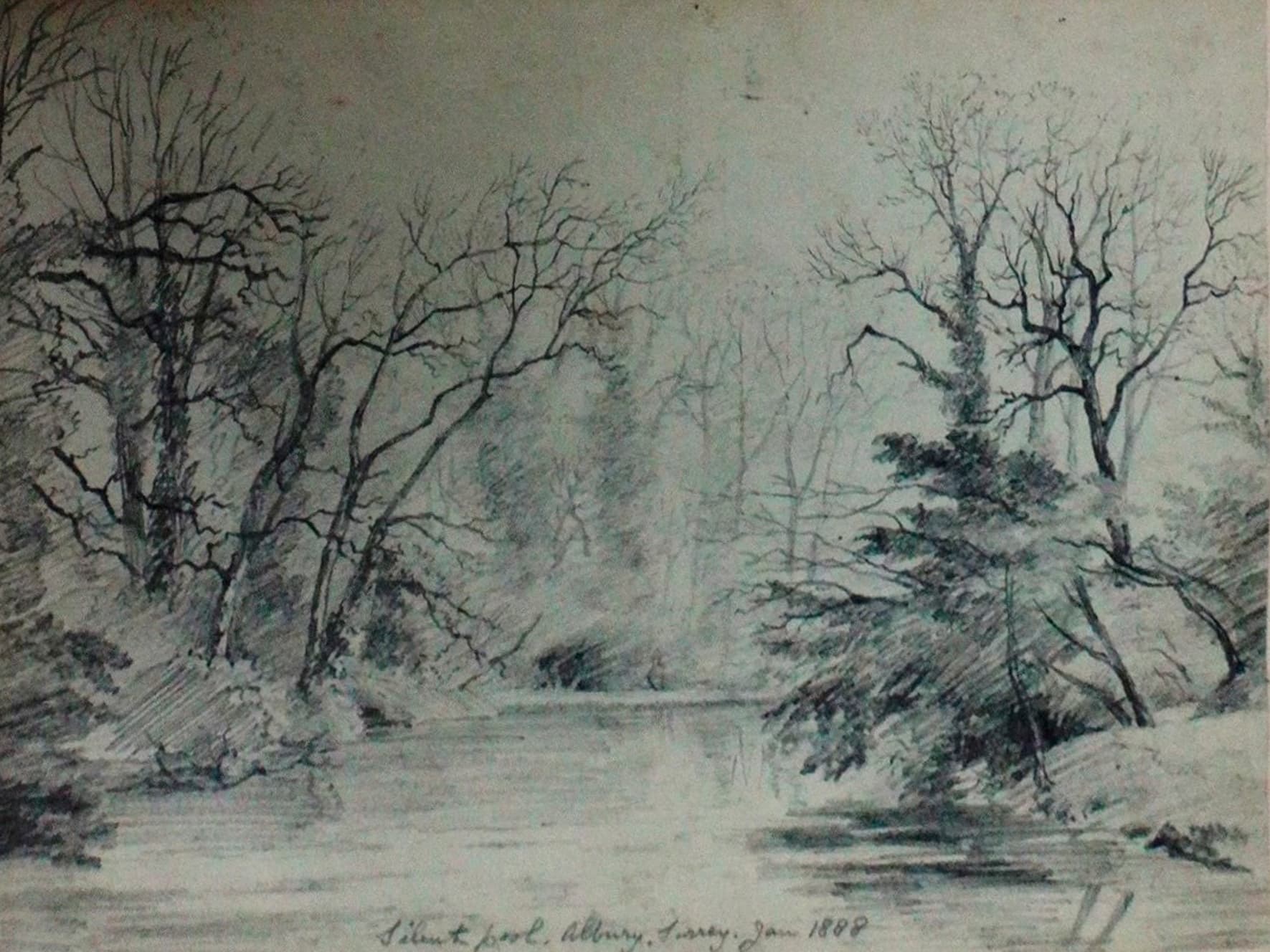
There are many variations of the legend of Silent Pool, but most begin with the woodcutter’s daughter, Emma – sometimes Alice – bathing in the tranquil water. It is generally believed that a nobleman on horseback approached her, and in an attempt to escape his advances, the girl swam to a deeper part of the lake and drowned. The nobleman, frightened, made his escape, leaving behind his hat which would be discovered by the woodcutter the next day, in search of his daughter. The hat bore the royal crest of Prince John, who later became Bad King John. The ghost of the woodcutter’s ill-fated daughter is said to be seen at midnight, dressed in virginal white, floating over the surface of the water and at times, the silence of the pool has reportedly been broken by Emma’s (or Alice’s) screams for mercy. However, the most common phenomena experienced at Silent Pool are strange noises and the feeling of being followed.
More recently, on December 11, 2002, Surrey police received a frenzy of calls reporting a car veering off the road near the A3 turn off to Burpham. This was no regular accident, and what unfolded afterwards has become local folklore.
In this article we’ll explore some of the most intriguing tales from our local area, including the chilling sightings of Guildford Castle, an unexplainable A3 apparition, the infamous legend of Silent Pool and more.
When the police went to investigate the incident, no trace of a crash was found, despite the numerous sightings. No tyre marks were on the road, nor any flattened foliage where the car was said to have crashed, and it took until the next morning, when dawn broke, for a car to be found. However, this car, a maroon Vauxhall Astra was covered in undergrowth, indicating that it had been there for much longer than one night. The wreckage was nose down in a ditch, invisible to the road above, and nearby lay the decomposed body of the driver who seemed to have survived the crash and managed to drag himself part way up the embankment in an attempt to get help, before dying. When he was discovered along with the car five months later, he was no more than a skeleton. The driver was eventually identified as Christopher Chandler, an alleged robber on the run from the police, who had been reported missing in July 2002 by his brother. But how could this be, when a multitude of witnesses saw the accident only the evening before? How could so many people have witnessed a crash five months after it occurred? Many believe that it must have been some sort of ghostly re-enactment of that fateful night.
One of Surrey’s most impressive ruins is the mighty Guildford Castle. Now known for its beautiful grounds, it was built shortly after the Norman conquest of 1066, and renovated around 2003. It seems to be these renovations that have stirred the slumbers of the castle’s oldest residents. In recent years, there have been a number of reports that visiting families have come running out of the castle’s ground floor carrying near hysterical children. These children have described witnessing an emaciated figure chained to the castle walls. Chillingly, the apparition was sighted in the part of the castle used as a prison for those incarcerated accused of serious crimes such as murder, and any prisoners would await their execution here, if found guilty. None of the children, of course, would have been aware of this.

The highest point to be seen from Guildford town centre is The Mount, where, in the 18th century, executions would be carried out in view of the high street. Halfway up The Mount sits The Mount Cemetery, where Alice’s Adventures In Wonderland author, Lewis Carrol, is buried. The Mount happens to be the setting for one of the most convincing photographs of a ghost. The picture features an unidentifiable spectral figure looming in the centre of a path, surrounded by spindly trees, and half obscured by the heavy fog. These were taken by Mark Baker, and the Director of The Ghost Finder Paranormal Society, Barri Ghai said “I am stuck for words on this one – these images have caused quite a stir among my team. We are actually convincing ourselves that this could be genuine, a real ghost, but obviously for us to say that without a full investigation of the area is a tough one.”
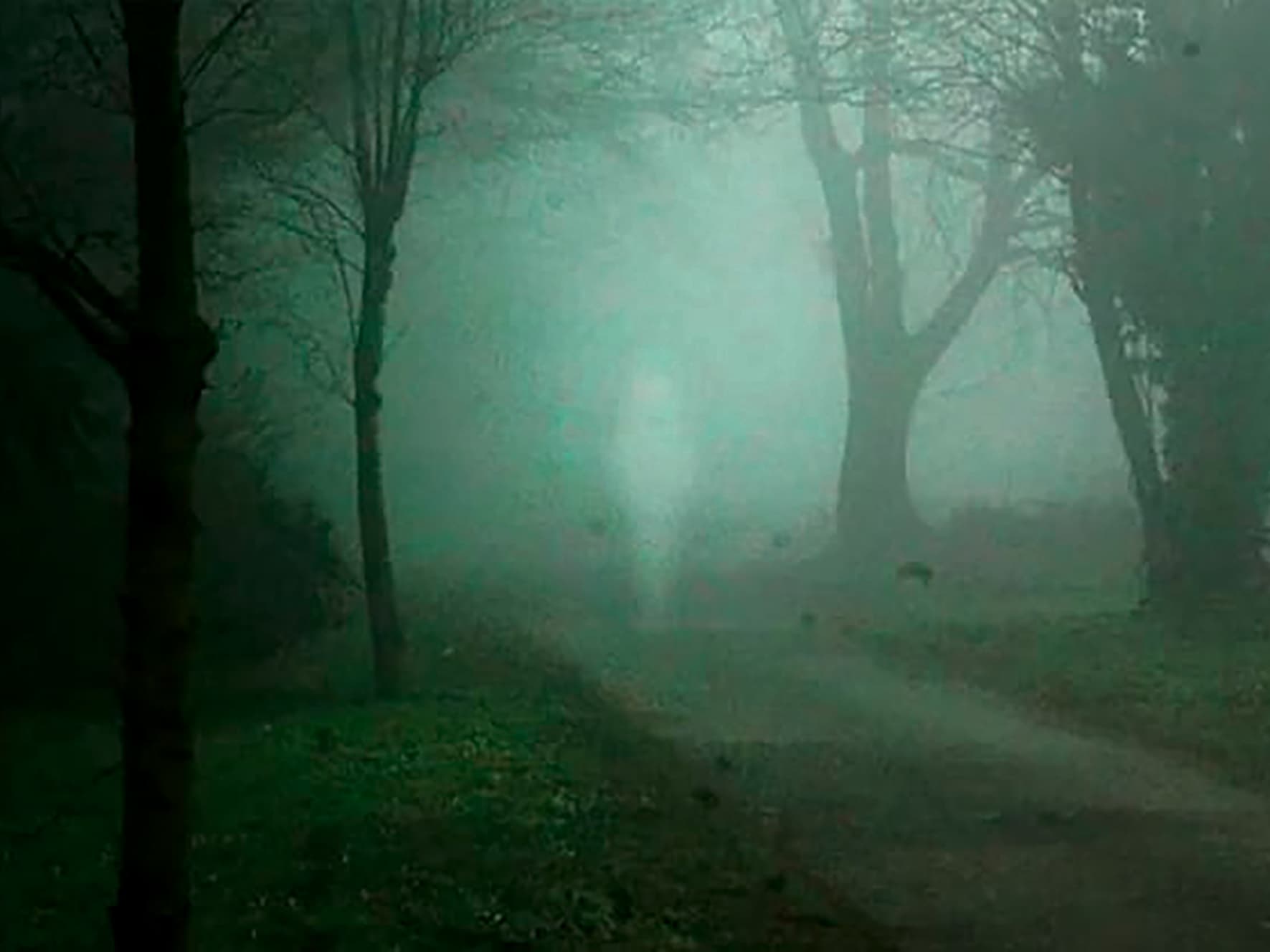
Guildford appears to be littered with paranormal attractions like The Angel Hotel and The King’s Head pub as well as the aforementioned locations and many more. Clearly, the town we live in boasts a rich and ghostly past of people who were once as alive as we are now, so what will our presence today create for the future?

